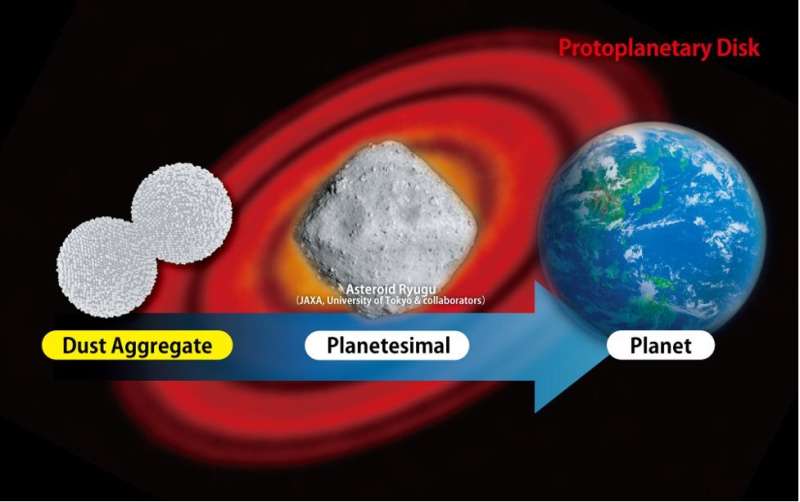This article has been reviewed according to Science X's editorial process and policies. Editors have highlighted the following attributes while ensuring the content's credibility:
fact-checked
peer-reviewed publication
trusted source
proofread
To stick or to bounce: Size determines the stickiness of cosmic dust aggregates

Microparticle dust aggregates, which are thought to play a role in the formation of new planets, are less likely to stick together after a collision when the aggregates are larger.
Current evidence suggests that microparticles of cosmic dust collide and stick together to form larger dust aggregates that may eventually combine and develop into planets. Numerical models that accurately characterize the conditions required for colliding microparticle aggregates to stick together, rather than bounce apart, are therefore paramount to understanding the evolution of planets. Recent modeling suggests that dust aggregates are less likely to stick together after a collision as the size of the aggregates increases.
A team of astrophysicists performed numerical simulations of dust aggregate collisions, with equal-mass aggregates varying between 10,000 and 140,000 microns in size, using soft-sphere discrete element methods. The discrete modeling system accounted for each particle within the aggregate rather than treating the aggregate as a single entity, and soft-sphere simulation assumed the rigidity of each particle of the aggregate but allowed for deformations that may occur during collision.
Their modeling indicated that increasing the radius of microparticle dust aggregates decreased the sticking probability, or likelihood that two aggregates would stick together and form a larger aggregate after collision. The team published the results of their study in the Astrophysical Journal Letters.
"The formation process of kilometer-sized bodies, planetesimals, from cosmic dust, which is the initial stage of planet formation, has been one of the biggest problems in the theory of planet formation," said Hidekazu Tanaka, one of the authors of the study and professor at the Astronomical Institute in the Graduate School of Science at Tohoku University in Sendai, Japan.
"The present study showed that the dust clumps that are the material for planets stop growing when they grow to a certain size, as large clumps are difficult to adhere to each other. Our results made the problem of planetesimal formation even more difficult. The adhesive growth of dust clumps is a key process in the planet-formation process."
The simulations suggest that collisional bouncing between large microparticle aggregates would decrease the formation of planetesimals, or the building blocks of planets. Kilometer-scale planetesimals form planets through collisional merging via mutual gravity.
Earlier modeling simulations and laboratory experiments characterizing the threshold for the sticking/bouncing barrier of dust aggregate collisions often produced conflicting results, which the research team and others hypothesized was due to varying sizes of aggregates. The results of the current study support this hypothesis.
It is currently unclear why the size of aggregates affects the sticking probability during a collision. Future studies aimed at dissecting the packing structure of aggregates over time may help scientists understand how aggregates can approach the scale of planetesimals. Studies of the contact sites between aggregates, where most energy is dissipated, after a collision may also unveil how larger aggregates eventually stick together.
Additionally, the simulations performed by the research team suggest that the sticking probability of particle aggregates may also be affected by the size of the individual particles that make up the aggregate and not just the radius of the entire aggregate.
The team acknowledges that the simulations they have performed in this study are far from comprehensive. Simulations that include aggregates that can be prepared by realistic procedures and that address acceleration will be performed, and laboratory experiments that will fine-tune the model are also planned.
Beyond these simulations, the team has their sights set on larger aggregates, which may fundamentally change current theories of planet development. "We will use a supercomputer to perform large-scale numerical simulations of collisions between even larger dust clumps in order to investigate how difficult it is for large dust clumps to attach to each other. This will help to settle the question of whether the formation of planetesimals is possible through the adhesion of dust clumps or not," said Tanaka.
More information: Sota Arakawa et al, Size Dependence of the Bouncing Barrier in Protoplanetary Dust Growth, The Astrophysical Journal Letters (2023). DOI: 10.3847/2041-8213/acdb5f
Journal information: Astrophysical Journal Letters
Provided by Tohoku University





















